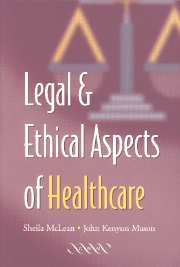Book contents
- Frontmatter
- Contents
- Acknowledgements
- Dedication
- Preface
- A Note on Abbreviations
- 1 About Medicine and the Law
- 2 Resources – Who Decides?
- 3 The Confidential Relationship
- 4 The Therapeutic Partnership
- 5 Refusal of Consent
- 6 Medical Negligence
- 7 Using People for Research
- 8 Assisted Reproduction
- 9 Genetics and Pregnancy
- 10 Termination of Pregnancy
- 11 Genetics, Insurance and Employment
- 12 Is Life Worth Living?
- 13 Disposal of the Body and Body Parts
- 14 Sex, Gender and the Law
- 15 Mental Health and Mental Capacity
- 16 The Law and the Elderly
- Index
13 - Disposal of the Body and Body Parts
Published online by Cambridge University Press: 24 August 2009
- Frontmatter
- Contents
- Acknowledgements
- Dedication
- Preface
- A Note on Abbreviations
- 1 About Medicine and the Law
- 2 Resources – Who Decides?
- 3 The Confidential Relationship
- 4 The Therapeutic Partnership
- 5 Refusal of Consent
- 6 Medical Negligence
- 7 Using People for Research
- 8 Assisted Reproduction
- 9 Genetics and Pregnancy
- 10 Termination of Pregnancy
- 11 Genetics, Insurance and Employment
- 12 Is Life Worth Living?
- 13 Disposal of the Body and Body Parts
- 14 Sex, Gender and the Law
- 15 Mental Health and Mental Capacity
- 16 The Law and the Elderly
- Index
Summary
Surprising though it may seem, it is a general legal principle that a person does not own his or her body or its individual parts – in short, there are no property rights in one's body. This is broadly true so long as property is defined as something you can deal with as you wish – which would include selling it or using it for barter. The law as applied to the body is, however, extraordinarily vague and is sometimes contradictory. No-one, for example, would deny that you can cut off your hair, and even sell it, say, to a wig-maker. At the other end of the scale, the law would certainly step in – and most people would say rightly so – if you decided to cut off your hand for any reason other than for medical treatment. Much of the current law is based on a very old case – dating from 1603 – involving just such a scenario in which a beggar had his hand removed so that he might attract more sympathetic donations. He and his collaborator were found guilty of the offence of maim. Similarly, in recent times, a group of men who were indulging in sado-masochistic practices were found guilty of inflicting criminal harm on each other and the propriety of the charge was upheld in the European Court of Human Rights – this despite the fact that the men concerned had given their free consent and the activities took place in private (R v Brown (1996)).
- Type
- Chapter
- Information
- Legal and Ethical Aspects of Healthcare , pp. 179 - 198Publisher: Cambridge University PressPrint publication year: 2003



